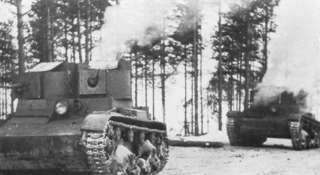
The Battle of Tolvajärvi was fought on 12 December 1939 between Finland and the Soviet Union. It was the first large offensive victory for the Finns in the Winter War.

Paavo Juho Talvela was a Finnish general of the infantry, Knight of the Mannerheim Cross and a member of the Jäger movement. He participated in the Eastern Front of World War I, the Finnish Civil War, the Finnish Kinship Wars, the Winter War and the Continuation War.
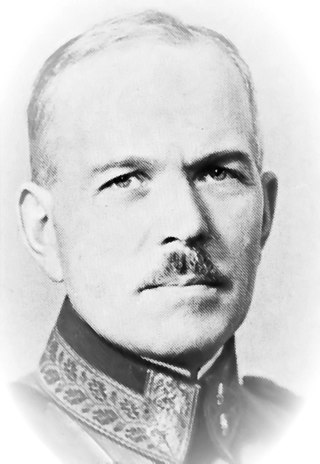
Karl Lennart Oesch was one of Finland's leading generals during World War II. He held a string of high staff assignments and front commands, and at the end of the Continuation War commanded three Finnish army corps on the Karelian Isthmus. He received numerous awards, including the Finnish Mannerheim Cross during his service. Following the end of the Continuation War, he was tried and convicted for war crimes relating to the treatment of Soviet prisoners-of-war.
The III Corps was a corps of the Finnish Army during the Continuation War, where Finland fought alongside Nazi Germany against the Soviet Union. Formed from the peacetime V Corps and subordinated to the German Army High Command Norway, III Corps fought initially in northern Finland on the flank of the German XXXVI Corps, participating in the Finno-German Operation Arctic Fox. In February 1944, it was moved to the Karelian Isthmus just prior to the launch of the Soviet Vyborg–Petrozavodsk offensive. Following the Moscow Armistice, III Corps took overall command of the Finnish forces participating in the Lapland War, the removal of German forces from northern Finland.
The Ryti–Ribbentrop letter of agreement was a personal letter from President of Finland Risto Ryti to German Führer Adolf Hitler signed on 26 June 1944. It was sent during the Soviet Vyborg–Petrozavodsk Offensive, which had started on 9 June and threatened to knock Finland out of the Continuation War.
The IV Corps was a formation of the Finnish Army during the Winter War against the Soviet Union. It defended the area north of Lake Ladoga against Soviet attacks. It was commanded by Major General Juho Heiskanen and from 4 December 1939 by Major General Woldemar Hägglund. The IV Corps defeated superior Soviet troops by using motti tactics.

The Battle of Ilomantsi was a part of the Svir–Petrozavodsk Offensive of the Continuation War (1941–1944). It was fought from 26 July to 13 August 1944, between Finland and the Soviet Union in an area roughly 40 kilometers wide and 30 kilometers deep, near the Finnish-Soviet border, close to the Finnish village of Ilomantsi, in North Karelia. The battle ended with a Finnish victory—the last major Soviet attack against Finland was stopped here.

The Finnish invasion of Ladoga Karelia was a military campaign carried out by Finland in 1941. It was part of what is commonly referred to as the Continuation War. Early in the war Finnish forces liberated the Ladoga Karelia. It had been ceded to the Soviet Union on 13 March 1940, in the Moscow Peace Treaty, which marked the end of the Winter War. Later, in the summer of 1944, the Soviet Union reconquered the eastern part of Ladoga Karelia in the Vyborg–Petrozavodsk Offensive.
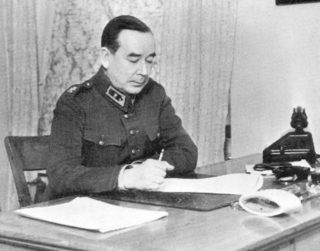
Johan Woldemar Hägglund was a Finnish lieutenant general during the Second World War, and an early volunteer of the Jäger Movement. He participated in the Eastern Front of World War I, the Finnish Civil War, the Winter War and the Continuation War, commanding army corps in the latter two. In 1944 and 1945, he was in charge of a committee investigating Finnish war crimes, especially those committed against prisoners of war.
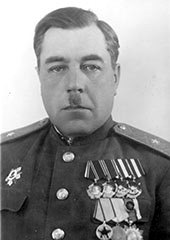
Roman Ivanovich Panin was a Soviet major general from during World War II. An Imperial Russian Army junior officer in World War I, he joined the Red Army in 1919. Panin fought in the Russian Civil War and continued to serve after the end of the Russian Civil War. He was an advisor to the National Revolutionary Army between 1938 and 1939. Later he participated in the Soviet-Finnish war as a corps commander, and during World War II as the commander of the 14th Army, commanding the defense of Murmansk during Operation Silver Fox. Panin became commander of the 2nd Reserve Army in May 1942 and two months later became a lecturer at the Frunze Military Academy. In February 1943 he became Volkhov Front chief of combat training and in September led the 7th Rifle Corps. After participating in the Leningrad–Novgorod Offensive, Panin briefly led the 99th Rifle Corps. In July 1944, Panin became deputy commander of the 5th Army. Hospitalized in February 1945 during the East Prussian Offensive, Panin did not see further action. After recovering he became an instructor at the Frunze Military Academy and retired in 1949. He died shortly afterwards.
7th Division was a Finnish Army division in the Continuation War. The division was formed Savo-Karjala military province from the men in Pohjois-Savo and Pohjois-Karjala civil guard districts.

Antero Johannes Svensson was a Finnish major general, a member of the Jäger Movement and a recipient of the Mannerheim Cross. He participated in the Eastern Front of World War I as a volunteer of the 27th Royal Prussian Jäger Battalion, in the Finnish Civil War as a platoon and squadron commander, the Winter War as a brigade and division commander, and the Continuation War as a division and corps commander.

Einar Nikolai Mäkinen was a Finnish lieutenant general and a member of the Jäger movement. He participated in the Eastern Front of World War I, the Finnish Civil War, the Winter War and the Continuation War. Before the Continuation War, he participated in negotiations with the Germans regarding plans for the war.
The II Corps was a unit of the Finnish Army during the Continuation War. During the war the corps participated in combat first northwest of Lake Ladoga and on the Karelian Isthmus before moving to the Povenets–Lake Segozero region by late 1941. During the Soviet offensive of 1944, the corps conducted a fighting retreat to the region of Ilomantsi, with parts of its forces participating in the subsequent Battle of Ilomantsi.
The IV Corps was a unit of the Finnish Army during the Continuation War. During the 1941 Finnish invasion of the Karelian Isthmus, it encircled three Soviet divisions in the area south of Vyborg before being renamed as Isthmus Group.
The V Corps was a unit of the Finnish Army during the Continuation War of 1941–1944. It was first active for a brief time in 1941, and was reactivated in 1942 in the Svir sector during the trench warfare phase of the war. Following the Soviet Vyborg–Petrozavodsk offensive, the corps was moved to the Karelian Isthmus, where it fought in the Battle of Vyborg Bay, stopping a Soviet amphibious operation to cross the Vyborg Bay.
The VI Corps was a corps of the Finnish Army during the Continuation War of 1941 to 1944, where the Finnish Army fought alongside Germans against the Soviet Union. The unit was formed during a reorganization of other Finnish army corps on 29 June 1941, prior to the start of Finnish offensive operations on the night of 9–10 July.
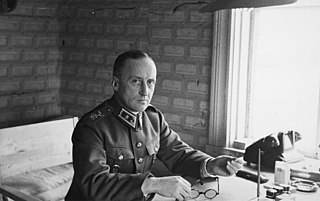
Aarne Leopold Blick was a Finnish lieutenant general, Knight of the Mannerheim Cross and a member of the Jäger movement. He participated in the Eastern Front of World War I, the Finnish Civil War, the Winter War and the Continuation War.
The VII Corps was a corps of the Finnish Army during the Continuation War of 1941 to 1944, where the Finnish Army fought alongside Germans against the Soviet Union. Under command of Major General Woldemar Hägglund, it took part in the Finnish invasions of Ladoga Karelia and East Karelia, including the capture of Petrozavodsk. During its existence, its composition varied significantly. It was disbanded in May 1943.
The Dolin Ski Brigade was a Red Army fighting unit led by Colonel Vjatšeslav Dmitrievitš Dolin during the Winter War. Well-equipped and composed primarily of Siberians with skiing expertise, the brigade was an elite unit. It was formed from three ski battalions of the 9th Soviet Army and was tasked with relieving the encircled 54th Rifle Division during the Battle of Kuhmo. The brigade was destroyed by Finnish forces during the battle, with the vast majority killed in action.









